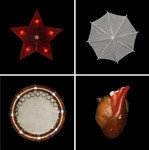Vladislav Efimov
dal 23/12/2009 al 13/2/2010
Segnalato da
23/12/2009
Vladislav Efimov
Stella Art Foundation, Moscow
A Fearful Collection. The artist is fascinated by the history of science, including the highly curious layer of ideas that are maybe too dogmatically labelled today as 'myths'. Such scientific antiques include a multitude of various concepts, from the alchemists' notion of the philosopher's stone through Bekhterev's universal 'neural current'.

The title of this project is meant to be taken literally. First, because Vladislav Efimov’s installation is indeed a collection of material artifacts. Secondly, because it is interactive. The objects in the collection react quite lively to a visitor’s presence: when the visitor touches the box which is the dwelling place of the object, its inhabitant expresses its fright by shrieking, hiding or singing.
The artist himself claims that he was interested in being able to reproduce a “system where there is no clear-cut separation between the human world, the material world and the world of ideas”. He cites the inspirational source of such system: the theory of Vladimir Bekhterev, the great Russian physiologist, who believed that “a human being’s various activities may be compared to the contractions of the pseudopodia of such protozoa like, for example, amoeba. On the other hand, what we usually see as complex reflexes is, after all, a derivative of the “contractibility” of living substance in response to external stimulation. The scientist believed that the foundation of the activity of living organisms is the neural current that is transformed, as muscles contract and parts of the body move, into mechanical energy. All the phenomena in the world, including its spiritual manifestations and all the processes that we see in living organisms derive from the universal cosmic energy; this energy, then, is the single substance of the universe. This cosmic energy is the beginning of the material and the spiritual worlds alike, and potentially contains in itself the entire being.”
Efimov is fascinated by the history of science, including the highly curious layer of ideas that are maybe too dogmatically labelled today as "myths". Such scientific antiques include a multitude of various concepts, from the alchemists' notion of the philosopher’s stone through Bekhterev’s universal “neural current”. They have also produced numerous material phenomena, with the Kunstkamera, or cabinet of curiosities, occupying the place of honour among them. It is the Kunstkamera that marked the starting point of a long history of neo-European collecting tradition. It registers the state of human mind that predates the insurmountable distinction between the objects of artificial and natural origin, a space shared, on equal footing, by “chef-d’oeuvres of Nature and Art alike”.
Efimov reproduces in his installation a "kunstkameraesque", non-hierarchical mode of display. All the objects collected by him – which include natural artifacts, applied art, everyday and technical objects – are enclosed in identical showcase boxes and displayed in a single row. Besides, they are animated, brought into the same category with living creatures, including the visitors. If we wanted to follow Efimov’s unquenchable passion for animating material objects to its roots, we should not forget that his first and primary artistic occupation was photography. Photography, the visual technology invented in the first half of the nineteenth century, seemed to its first contemporaries to be nothing short of a miracle. It did not merely take a two-dimensional copy of a thing; rather, it seemed to preserve in it a fine image of the materiality of the object it reproduced: it transformed, as it were, the still life of traditional art into a wonderful portrait that contained part of the very soul of the original. Photography was understood as a trap for reality, as it were, and the greater the similarity attained by it, the more it was transfigured, as people thought, from technique into magic. This explains why people of that time strived to create a full archive of copies of the entirety of objects constituting their world. To quote one of the photo-activists of the time, in the future “images is going to become more important than the material object itself, essentially making the object superfluous.” Ideally, photography was supposed to encompass the virtues of both art and science to create something that would fulfill the role of a comprehensive library of images, on the one hand, and of a museum of all things, on the other.
Efremov’s first attempts at photography were essentially “portraits” of things against simple backgrounds: each represented a single object as well as a "keeping unit" of this universal archive. But, while this pattern essentially never changed; Efimov’s objects, increasingly, were showing a tendency to break free from their two-dimensional cage, trying to turn now into stereo-images, now in digitally animated pictures. At some point, they succeeded in their escape, and Efimov’s 1997 project Originals featured, instead of boxed frames, three-dimensional boxes with the objects themselves, hitherto always hidden from direct contact with the audience. This installation, the Fearful Collection, is presented in the same line of “alchemical activity”. Things not only gain volume and density, they are also given a voice and a capacity to move and to initiate basic communication with their surroundings. By the will of the artist, the thought of the physiologist philosopher and the power of technology, they are set in the endless line of creatures run through by the unifying neural current of life.
Press enquiries
Anna Svergun Phone/Fax + 7 495 6979530 svergun@inbox.ru
Opening 24 december 2009
Stella Art Foundation
Skariatinskiy Pereulok 7 / Mytnaya ul. 62 - Moscow
Opening Hours: Tuesday - Sunday, 10:30 - 18:30



